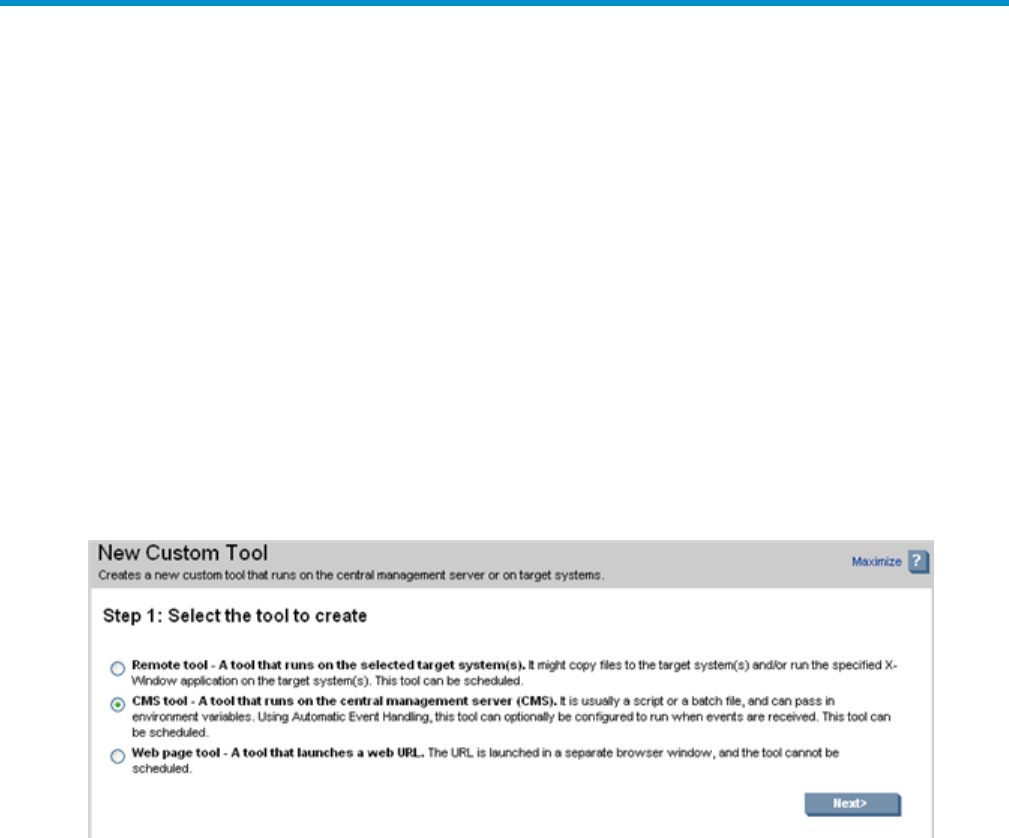HP Systems Insight Manager 7.0 User Guide
Table Of Contents
- Systems Insight Manager 7.0 User Guide
- Table of Contents
- Part I Introduction
- Part II Setting up HP SIM
- 3 Setting up managed systems
- 4 Credentials
- 5 WMI Mapper Proxy
- 6 Discovery
- 7 Manage Communications
- 8 Automatic event handling
- 9 Users and Authorizations
- 10 Managed environment
- Part III HP SIM basic features
- 11 Basic and advanced searches
- 12 Monitoring systems
- 13 Event management
- 14 Reporting in HP SIM
- 15 HP SIM tools
- Part IV HP SIM advanced features
- 16 Collections in HP SIM
- 17 HP SIM custom tools
- 18 Federated Search
- 19 CMS reconfigure tools
- 20 Understanding HP SIM security
- 21 Privilege elevation
- 22 Contract and warranty
- 23 License Manager
- 24 Storage integration using SMI-S
- 25 Managing MSCS clusters
- 26 HP SIM Audit log
- 27 HP Version Control and HP SIM
- 28 Compiling and customizing MIBs
- A Important Notes
- System and object names must be unique
- Setting the Primary DNS Suffix for the CMS
- Distributed Systems Administration Utilities menu options not available
- Virtual machine guest memory reservation size
- Insight Remote Support Advanced compatibility
- Database firewall settings
- Annotating the portal UI
- Security bulletins
- Validating RPM signatures
- Central Management Server
- Complex systems displaying inconsistency with the number of nPars within the complex
- Configure or Repair Agents
- Data collection reports
- B Troubleshooting
- Authentication
- Browser
- Central Management Server
- Complex
- Configure or Repair Agents
- Container View
- Credentials
- Data Collection
- Database
- Discovery
- iLO
- Linux servers
- Event
- Host name
- HP Insight Control power management
- Insight Control virtual machine management
- HP Smart Update Manager
- Systems Insight Manager
- Identification
- Installation
- License Manager
- Locale
- Managed Environment
- HP MIBs
- Onboard Administrator
- OpenSSH
- Performance
- Ports used by HP SIM.
- Privilege elevation
- Property pages
- Reporting
- Security
- Sign-in
- SNMP settings
- SSH communication
- System Page
- System status
- Target selection wizard
- Tasks
- Tools
- Upgrade
- UUID
- Virtual identifiers
- Virtual machines
- VMware
- WBEM
- WBEM indications
- WMI Mapper
- C Protocols used by HP SIM
- D Data Collection
- E Default system tasks
- Biweekly Data Collection
- System Identification
- Old Noisy Events
- Events Older Than 90 Days
- Status Polling for Non Servers
- Status Polling for Servers
- Status Polling for Systems No Longer Disabled
- Hardware Status Polling for Superdome 2 Onboard Administrator
- Data Collection
- Hardware Status Polling
- Version Status Polling
- Version Status Polling for Systems no Longer Disabled
- Check Event Configuration
- Status polling
- F Host file extensions
- G System Type Manager rules
- H Custom tool definition files
- I Out-of-the-box MIB support in HP SIM
- J Support and other resources
- Glossary
- Index

17 HP SIM custom tools
General concepts
Custom tools are tools that can be created by the user to run on the CMS or on target systems. For
example:
• Remote tool A tool that runs on selected target systems. It might copy files to the target
systems or run specific X-Window applications on the target systems. You can schedule this
tool.
• CMS tool A tool that runs on the CMS. It is usually a script or batch file and can pass in
environment variables. Using Automatic Event Handling, you can configure this tool to run
when events are received. You can schedule this tool.
• Web page tool A tool that launches a web URL. The URL is launched in a separate browser
window on the CMS. You cannot schedule this tool.
To add custom tools, you can either use the Tools→Custom Tools→New Custom Tools menu
in the GUI, or edit the tool definition files (tdefs) in a text editor and register them with the CLI
mxtool. Both procedures are explained in this chapter.
Tool types
As delivered, HP SIM provides an administrator with unified management control of any number
of servers and storage devices from a single console in the data center or in a remote location.
When customized with specialized tools or Insight Essentials Value Added Software plug-ins, HP
SIM becomes a comprehensive, easy-to-use platform for controlling Microsoft Windows, Linux, or
HP-UX enterprise environments.
A key method of administering multiple systems is through scripting. HP SIM features a modular
architecture that uses tool definition files (TDEFs) written in the XML data file format. A TDEF contains
the definitions of one or more tools used by HP SIM and define how a tool launches and executes.
A tool can be a script or an executable file. Creating custom tools enables you to extend the use
of HP SIM to your specific business environment.
General concepts 97










